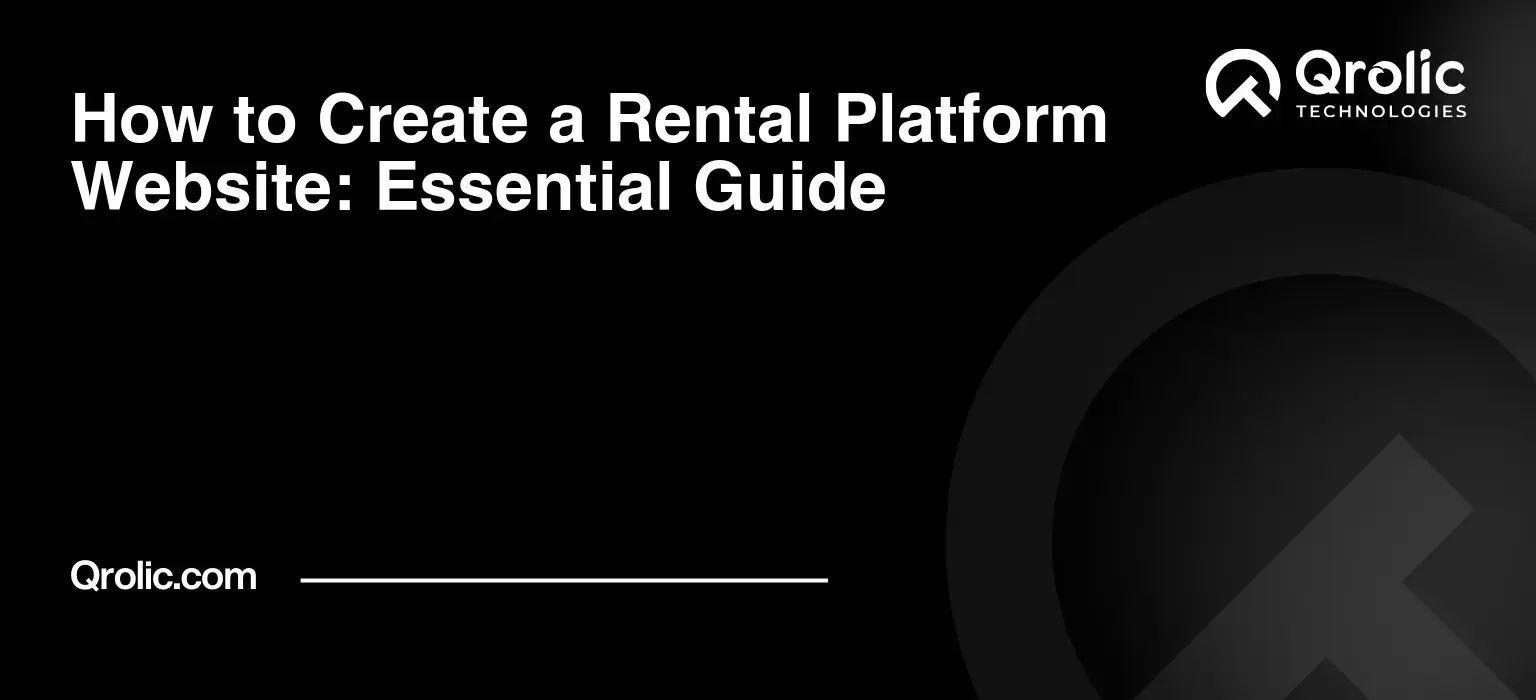Quick Summary:
- Define your niche and target audience clearly.
- Build with essential features and great user experience.
- Prioritize security, effective marketing, and scalability.
- Consider expert partners for development success.
Table of Contents
- 1. Understanding the Landscape: Why Rental Platforms are Booming
- 1.1. The Rise of the Sharing Economy and Rental Culture
- 1.2. Identifying Niche Opportunities in the Rental Market
- 1.3. Analyzing the Competitive Landscape: Key Players and Their Strategies
- 2. Planning Your Rental Platform: The Foundation for Success
- 2.1. Defining Your Target Audience and Their Needs
- 2.2. Defining Your Core Features: Functionality that Matters
- 2.3. Choosing the Right Business Model: Monetizing Your Platform
- 3. Property Design: Crafting a User-Centric Experience
- 3.1. User Interface (UI) Design: Simplicity and Intuition
- 3.2. User Experience (UX) Design: Smooth and Seamless Interactions
- 3.3. Visual Hierarchy: Guiding Users Through the Platform
- 4. Technology Stack: Choosing the Right Tools
- 4.1. Frontend Development: Technologies for a Dynamic User Interface
- 4.2. Backend Development: Powering the Platform’s Functionality
- 4.3. Database Management: Storing and Organizing Your Data
- 4.4. APIs and Integrations: Connecting to Third-Party Services
- 5. Development Process: Building Your Platform Step-by-Step
- 5.1. Agile Development Methodology: Iterative and Flexible
- 5.2. Version Control: Managing Your Codebase
- 5.3. Testing: Ensuring Quality and Reliability
- 5.4. Deployment: Launching Your Platform
- 6. Marketing and Promotion: Getting the Word Out
- 6.1. Search Engine Optimization (SEO): Driving Organic Traffic
- 6.2. Social Media Marketing: Engaging Your Audience
- 6.3. Content Marketing: Providing Value and Building Authority
- 6.4. Email Marketing: Nurturing Leads and Retaining Customers
- 7. Legal and Security Considerations: Protecting Your Business and Users
- 7.1. Terms of Service and Privacy Policy: Protecting Your Rights and User Data
- 7.2. Secure Payment Processing: Protecting Financial Information
- 7.3. Data Security: Protecting User Data from Breaches
- 7.4. Insurance: Protecting Against Liability
- 8. Scaling Your Platform: Preparing for Growth
- 8.1. Scalable Infrastructure: Handling Increased Traffic and Data
- 8.2. Automation: Streamlining Processes and Reducing Costs
- 8.3. Internationalization: Expanding Your Reach
- 8.4. Continuous Improvement: Adapting to Changing Needs
- 9. Qrolic Technologies: Your Partner in Building a Successful Rental Platform
- 9.1. Why Choose Qrolic Technologies?
- 9.2. Qrolic Technologies Services for Rental Platform Development
- 9.3. Let Qrolic Technologies Help You Build Your Dream Rental Platform
- 10. Conclusion: Your Journey to Rental Platform Success
1. Understanding the Landscape: Why Rental Platforms are Booming
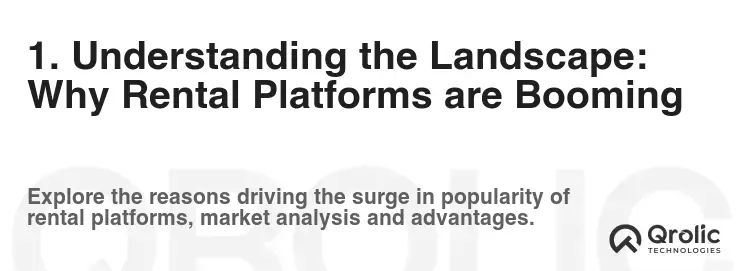
1.1. The Rise of the Sharing Economy and Rental Culture
The world is shifting. We’re moving away from a culture of ownership towards one of access. Why buy a power drill you’ll use twice a year when you can rent one? This “sharing economy” is fueled by convenience, cost-effectiveness, and a growing awareness of sustainability. Think about it – renting reduces waste, minimizes storage needs, and often provides access to higher-quality items than many individuals could afford to purchase outright. This trend applies across a huge range of sectors, from cars and tools to clothing and, most significantly, property.
- Convenience: Instant access to needed items without long-term commitment.
- Cost-Effectiveness: Paying only for usage, avoiding purchase price, maintenance, and depreciation.
- Sustainability: Reduced consumption and waste by sharing resources.
1.2. Identifying Niche Opportunities in the Rental Market
While established giants dominate some rental sectors, niche opportunities abound. Think beyond apartments and vacation homes. What about:
- Equipment Rental: Construction equipment, photography gear, event supplies.
- Experience Rental: Renting unique experiences like boat trips, cooking classes, or guided tours.
- Specialized Goods: Designer clothing, baby equipment, sporting goods.
- Co-working Spaces: Flexible office solutions for freelancers and small businesses.
- Event Spaces: Venues for parties, weddings, and corporate events.
By focusing on a specific niche, you can tailor your platform to a specific audience, offering a more targeted and valuable service. This allows you to build a loyal user base and establish yourself as a leader in your chosen field.
1.3. Analyzing the Competitive Landscape: Key Players and Their Strategies
Before diving in, understand your competition. Identify key players in your chosen niche and analyze their strategies. Consider:
- Their Strengths: What are they doing well?
- Their Weaknesses: Where are they falling short?
- Their Target Audience: Who are they trying to reach?
- Their Pricing Model: How do they charge for rentals?
- Their User Experience: How easy is it to use their platform?
- Their Marketing Strategies: How do they attract customers?
By studying your competitors, you can identify opportunities to differentiate yourself and create a platform that offers a unique and compelling value proposition. Don’t just copy what they’re doing; learn from their mistakes and build on their successes.
2. Planning Your Rental Platform: The Foundation for Success
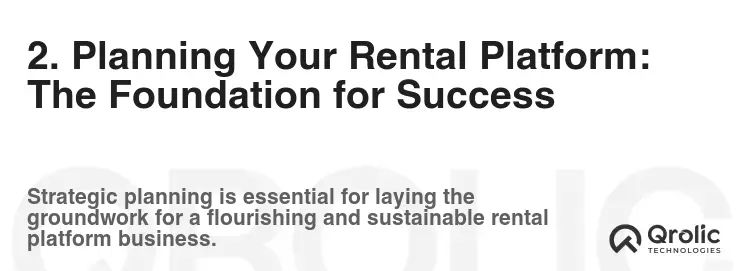
2.1. Defining Your Target Audience and Their Needs
Who are you building this platform for? Understanding your target audience is crucial for making informed decisions about features, design, and marketing. Create detailed user personas that represent your ideal customers. Consider:
- Demographics: Age, location, income, education.
- Psychographics: Interests, values, lifestyle.
- Pain Points: What challenges are they facing when trying to rent items?
- Needs and Desires: What are they looking for in a rental platform?
For example, if you’re targeting young professionals looking for short-term apartment rentals, your platform might focus on ease of use, mobile accessibility, and features like instant booking and virtual tours. If you’re targeting construction companies looking for equipment rentals, your platform might focus on detailed equipment specifications, delivery options, and insurance coverage.
2.2. Defining Your Core Features: Functionality that Matters
What are the essential features that your rental platform needs to succeed? Prioritize features that directly address the needs of your target audience and provide a seamless user experience. Consider these core features:
- Listing Management: Easy-to-use tools for listing items for rent, including detailed descriptions, high-quality photos, and accurate pricing.
- Search and Filtering: Powerful search functionality that allows users to quickly find the items they need, with robust filtering options based on location, price, availability, and other relevant criteria.
- Booking and Payment: Secure and reliable booking and payment processing system, with options for various payment methods and transparent pricing.
- User Profiles: Comprehensive user profiles for both renters and owners, with the ability to manage listings, track bookings, and communicate with other users.
- Reviews and Ratings: A system for users to leave reviews and ratings for items and owners, building trust and transparency within the platform.
- Communication System: Integrated messaging system for renters and owners to communicate directly with each other, ask questions, and coordinate logistics.
- Admin Panel: A robust admin panel for managing users, listings, payments, and other aspects of the platform.
2.3. Choosing the Right Business Model: Monetizing Your Platform
How will you generate revenue from your rental platform? Several business models are commonly used:
- Commission-Based: Charging a percentage of each rental transaction. This is a popular model as it aligns your incentives with the success of your users.
- Subscription-Based: Charging users a monthly or annual fee for access to the platform and its features. This can provide a more predictable revenue stream.
- Listing Fees: Charging owners a fee to list their items on the platform. This can be a good option if you have a large number of listings.
- Advertising: Displaying advertisements on the platform. This can be a good source of revenue if you have a large user base.
- Premium Features: Offering optional premium features for an additional fee, such as enhanced listing visibility or priority customer support.
Choose a business model that aligns with your target audience, your chosen niche, and your overall business goals. Consider the pros and cons of each model and choose the one that is most likely to generate sustainable revenue.
3. Property Design: Crafting a User-Centric Experience
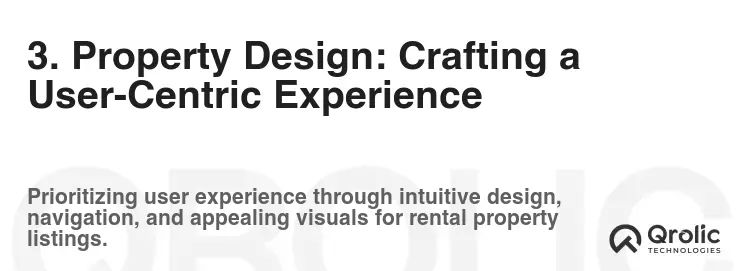
3.1. User Interface (UI) Design: Simplicity and Intuition
Your platform’s user interface (UI) is the first thing users will see, and it can make or break their experience. Focus on simplicity and intuition:
- Clean and Modern Design: Avoid clutter and use a clean, modern design that is visually appealing and easy to navigate.
- Intuitive Navigation: Ensure that users can easily find what they are looking for with clear and intuitive navigation.
- Mobile-First Approach: Design your platform with mobile users in mind, ensuring that it is responsive and works seamlessly on all devices.
- Consistent Branding: Use consistent branding throughout the platform, including colors, fonts, and imagery.
3.2. User Experience (UX) Design: Smooth and Seamless Interactions
User experience (UX) is about more than just aesthetics; it’s about how users interact with your platform. Ensure a smooth and seamless experience:
- Easy Search and Filtering: Make it easy for users to find the items they need with powerful search and filtering options.
- Streamlined Booking Process: Simplify the booking process as much as possible, minimizing the number of steps required to complete a booking.
- Clear and Concise Information: Provide clear and concise information about each item, including detailed descriptions, high-quality photos, and accurate pricing.
- Responsive Customer Support: Provide responsive customer support to address user questions and concerns.
3.3. Visual Hierarchy: Guiding Users Through the Platform
Visual hierarchy is the arrangement of elements on a page to guide the user’s eye and highlight important information. Use:
- Size and Contrast: Use size and contrast to draw attention to key elements, such as headings, buttons, and calls to action.
- Spacing and Alignment: Use spacing and alignment to create a clean and organized layout.
- Color and Typography: Use color and typography to create a visual hierarchy and guide the user’s eye.
- Whitespace: Use whitespace to create a sense of balance and clarity.
4. Technology Stack: Choosing the Right Tools
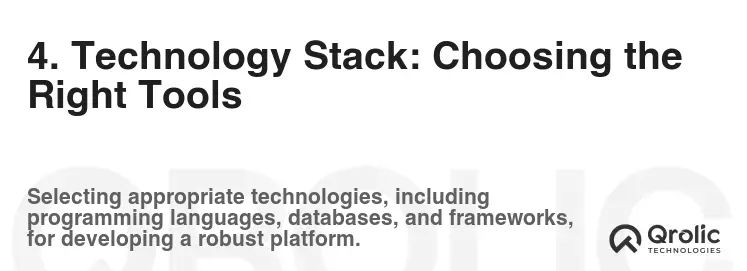
4.1. Frontend Development: Technologies for a Dynamic User Interface
The frontend is what users see and interact with. Popular technologies include:
- React: A JavaScript library for building user interfaces. Known for its component-based architecture and performance.
- Angular: A TypeScript-based framework for building complex web applications. Offers a comprehensive set of features and tools.
- Vue.js: A progressive JavaScript framework for building user interfaces. Easy to learn and use, and highly flexible.
- HTML, CSS, and JavaScript: The fundamental building blocks of the web. Essential for creating the structure, style, and behavior of your platform.
Consider factors like ease of use, performance, scalability, and community support when choosing your frontend technology.
4.2. Backend Development: Powering the Platform’s Functionality
The backend handles the server-side logic, database interactions, and API management. Popular technologies include:
- Node.js: A JavaScript runtime environment that allows you to run JavaScript on the server. Known for its scalability and performance.
- Python (Django/Flask): Python is a versatile language with powerful frameworks like Django and Flask for building web applications.
- Ruby on Rails: A popular framework for building web applications quickly and easily.
- PHP (Laravel): A widely used language with frameworks like Laravel for building robust web applications.
Consider factors like scalability, security, maintainability, and development speed when choosing your backend technology.
4.3. Database Management: Storing and Organizing Your Data
A database is essential for storing and managing your platform’s data, including user information, listings, and bookings. Popular options include:
- MySQL: A popular open-source relational database management system.
- PostgreSQL: Another popular open-source relational database management system, known for its advanced features and reliability.
- MongoDB: A NoSQL database that is well-suited for handling large amounts of unstructured data.
- Firebase: A cloud-based database that is easy to use and scale.
Consider factors like scalability, security, performance, and data structure when choosing your database.
4.4. APIs and Integrations: Connecting to Third-Party Services
Integrate with third-party services to enhance your platform’s functionality. Consider:
- Payment Gateways: Integrate with payment gateways like Stripe or PayPal to process payments securely.
- Mapping Services: Integrate with mapping services like Google Maps to display locations and provide directions.
- Email Marketing Services: Integrate with email marketing services like Mailchimp to send email newsletters and promotional offers.
- SMS Messaging Services: Integrate with SMS messaging services like Twilio to send booking confirmations and reminders.
5. Development Process: Building Your Platform Step-by-Step
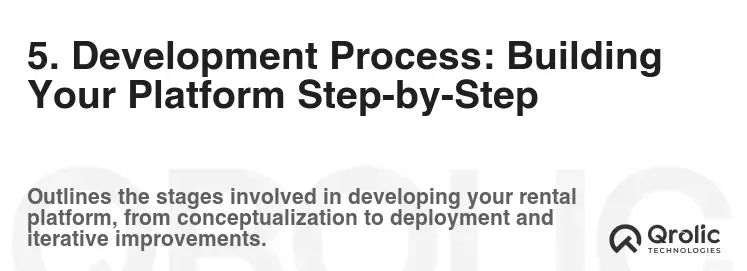
5.1. Agile Development Methodology: Iterative and Flexible
Adopt an agile development methodology to ensure flexibility and adaptability throughout the development process. This involves:
- Sprints: Breaking down the development process into short, iterative sprints.
- Daily Stand-ups: Holding daily stand-up meetings to discuss progress and identify roadblocks.
- Sprint Reviews: Reviewing the work completed during each sprint and gathering feedback.
- Retrospectives: Reflecting on the sprint and identifying areas for improvement.
Agile development allows you to respond quickly to changing requirements and ensure that your platform meets the needs of your users.
5.2. Version Control: Managing Your Codebase
Use a version control system like Git to manage your codebase and track changes. This allows you to:
- Collaborate with other developers: Work on the same code simultaneously without conflicts.
- Track changes: See who made what changes and when.
- Revert to previous versions: Easily revert to a previous version of the code if something goes wrong.
- Branching and Merging: Create branches to work on new features or bug fixes without affecting the main codebase.
5.3. Testing: Ensuring Quality and Reliability
Thorough testing is crucial for ensuring the quality and reliability of your platform. Implement various types of testing:
- Unit Testing: Testing individual components of the code to ensure that they work correctly.
- Integration Testing: Testing the interactions between different components of the code.
- User Acceptance Testing (UAT): Testing the platform from the perspective of the user to ensure that it meets their needs.
- Performance Testing: Testing the platform’s performance under different load conditions.
5.4. Deployment: Launching Your Platform
Once you have thoroughly tested your platform, you are ready to deploy it. Choose a reliable hosting provider and follow best practices for deployment. Consider:
- Cloud Hosting: Using cloud hosting providers like AWS, Google Cloud, or Azure for scalability and reliability.
- Continuous Integration/Continuous Deployment (CI/CD): Automating the deployment process to ensure that changes are deployed quickly and reliably.
- Monitoring and Logging: Implementing monitoring and logging to track the platform’s performance and identify any issues.
6. Marketing and Promotion: Getting the Word Out
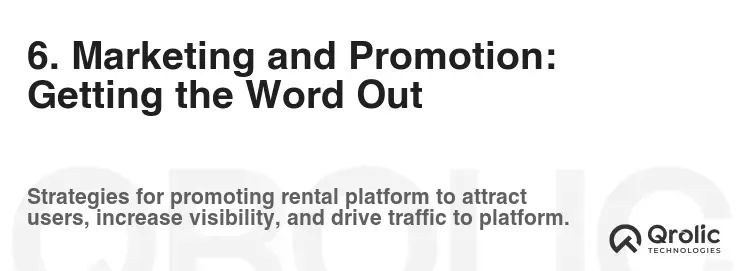
6.1. Search Engine Optimization (SEO): Driving Organic Traffic
Optimize your platform for search engines to drive organic traffic. This involves:
- Keyword Research: Identifying relevant keywords that your target audience is searching for.
- On-Page Optimization: optimizing your website’s content and structure for search engines.
- Off-Page Optimization: Building backlinks from other websites to improve your website’s authority.
- Technical SEO: Ensuring that your website is technically sound and easy for search engines to crawl.
6.2. Social Media Marketing: Engaging Your Audience
Use social media to engage your audience and promote your platform. This involves:
- Creating Engaging Content: Creating content that is relevant and interesting to your target audience.
- Building a Community: Building a community of followers and engaging with them regularly.
- Running Contests and Giveaways: Running contests and giveaways to attract new followers and generate buzz.
- Using Paid Advertising: Using paid advertising to reach a wider audience.
6.3. Content Marketing: Providing Value and Building Authority
Create valuable content that educates and informs your target audience. This can include:
- Blog Posts: Writing blog posts on topics related to your niche.
- Infographics: Creating infographics that visually represent data and information.
- Videos: Creating videos that showcase your platform and its features.
- Case Studies: Creating case studies that highlight the success of your users.
6.4. Email Marketing: Nurturing Leads and Retaining Customers
Build an email list and use email marketing to nurture leads and retain customers. This involves:
- Offering a Lead Magnet: Offering a valuable free resource in exchange for email addresses.
- Sending Regular Newsletters: Sending regular newsletters that provide valuable content and updates.
- Segmenting Your List: Segmenting your list based on user behavior and demographics.
- Automating Your Emails: Automating your emails to send targeted messages based on user actions.
7. Legal and Security Considerations: Protecting Your Business and Users
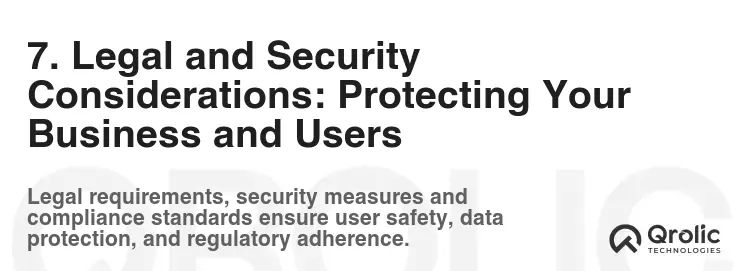
7.1. Terms of Service and Privacy Policy: Protecting Your Rights and User Data
Develop comprehensive terms of service and privacy policy to protect your rights and user data. Consult with a legal professional to ensure that these documents are compliant with all applicable laws and regulations.
7.2. Secure Payment Processing: Protecting Financial Information
Implement secure payment processing to protect your users’ financial information. Use a PCI-compliant payment gateway and follow best practices for data security.
7.3. Data Security: Protecting User Data from Breaches
Implement robust data security measures to protect user data from breaches. This includes:
- Encryption: Encrypting sensitive data both in transit and at rest.
- Access Control: Implementing strict access control policies to limit access to sensitive data.
- Regular Security Audits: Conducting regular security audits to identify and address vulnerabilities.
- Incident Response Plan: Developing an incident response plan to handle security breaches.
7.4. Insurance: Protecting Against Liability
Obtain appropriate insurance coverage to protect against liability. This may include:
- General Liability Insurance: Protecting against claims of bodily injury or property damage.
- Professional Liability Insurance: Protecting against claims of negligence or errors in your services.
- Cyber Liability Insurance: Protecting against losses resulting from cyber attacks.
8. Scaling Your Platform: Preparing for Growth
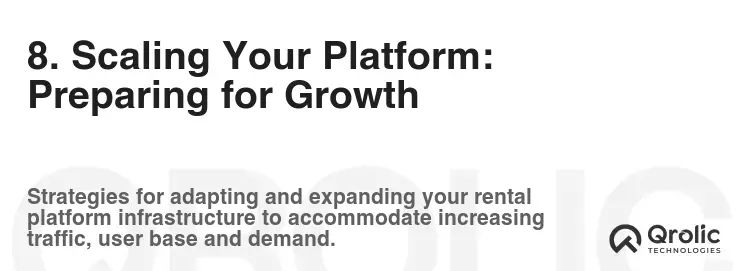
8.1. Scalable Infrastructure: Handling Increased Traffic and Data
Ensure that your platform has a scalable infrastructure to handle increased traffic and data. This may involve:
- Cloud Hosting: Using cloud hosting providers that can automatically scale resources as needed.
- Load Balancing: Distributing traffic across multiple servers to prevent overload.
- Database Optimization: optimizing your database to handle large amounts of data.
- Caching: Caching frequently accessed data to improve performance.
8.2. Automation: Streamlining Processes and Reducing Costs
Automate processes to streamline operations and reduce costs. This can include:
- Automated Customer Support: Using chatbots to handle common customer inquiries.
- Automated Marketing: Automating email marketing and social media posting.
- Automated Billing and Payments: Automating billing and payment processing.
- Automated Reporting: Automating the generation of reports and dashboards.
8.3. Internationalization: Expanding Your Reach
Consider internationalizing your platform to expand your reach to new markets. This involves:
- Translation: Translating your platform into multiple languages.
- Localization: Adapting your platform to the cultural norms and preferences of different countries.
- Currency Support: Supporting multiple currencies.
- Payment Gateway Integration: Integrating with payment gateways that are popular in different countries.
8.4. Continuous Improvement: Adapting to Changing Needs
Continuously improve your platform based on user feedback and market trends. This involves:
- Collecting User Feedback: Actively soliciting user feedback through surveys, feedback forms, and user interviews.
- Analyzing Data: Analyzing data to identify areas for improvement.
- A/B Testing: Conducting A/B tests to compare different versions of features and identify which performs best.
- Staying Up-to-Date: Staying up-to-date with the latest technologies and trends.
9. Qrolic Technologies: Your Partner in Building a Successful Rental Platform
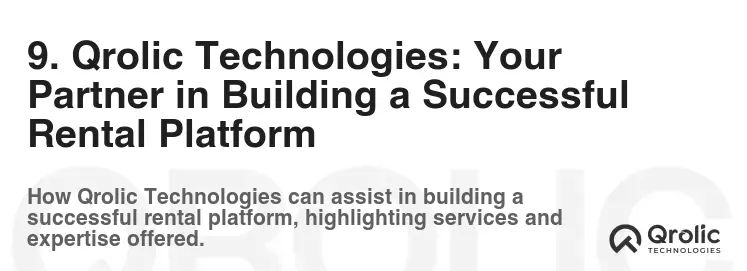
Qrolic Technologies (https://qrolic.com/) is a leading software development company specializing in building scalable and robust platforms for businesses of all sizes. With a proven track record of delivering high-quality solutions, Qrolic Technologies can be your trusted partner in creating a successful rental platform.
9.1. Why Choose Qrolic Technologies?
- Expertise: Deep expertise in building rental platforms and other online marketplaces.
- Custom Solutions: Tailored solutions to meet your specific needs and requirements.
- Scalability: Focus on building scalable platforms that can handle future growth.
- Security: Commitment to implementing robust security measures to protect your data and users.
- Agile Development: Agile development methodology for flexibility and responsiveness.
- Dedicated Support: Dedicated support team to assist you throughout the development process and beyond.
9.2. Qrolic Technologies Services for Rental Platform Development
- Frontend Development: Building user-friendly and engaging interfaces.
- Backend Development: Developing robust and scalable server-side logic.
- Database Design and Management: Designing and managing efficient databases.
- API Integration: Integrating with third-party services and APIs.
- Testing and Quality Assurance: Ensuring the quality and reliability of your platform.
- Deployment and Maintenance: Deploying and maintaining your platform on reliable infrastructure.
9.3. Let Qrolic Technologies Help You Build Your Dream Rental Platform
Contact Qrolic Technologies today to discuss your rental platform project and learn how they can help you bring your vision to life. Visit https://qrolic.com/ to learn more.
10. Conclusion: Your Journey to Rental Platform Success
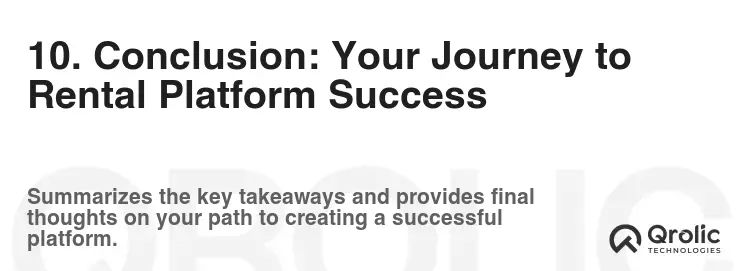
Creating a successful rental platform website requires careful planning, execution, and ongoing optimization. By understanding the landscape, defining your target audience, choosing the right technology stack, implementing robust security measures, and promoting your platform effectively, you can build a thriving online marketplace. Partnering with a company like Qrolic Technologies can significantly increase your chances of success. Remember to stay adaptable, continuously improve your platform, and always focus on providing value to your users. Your journey to rental platform success starts now!
